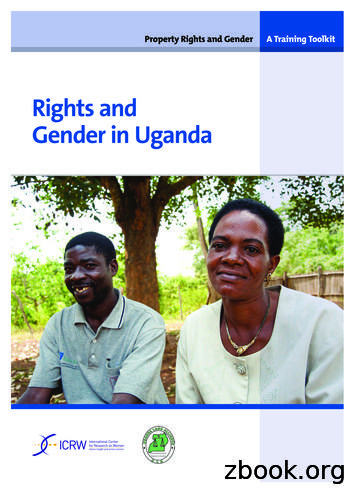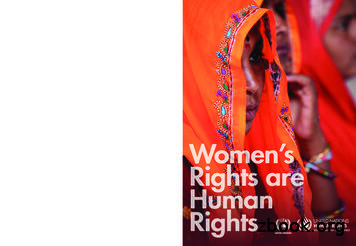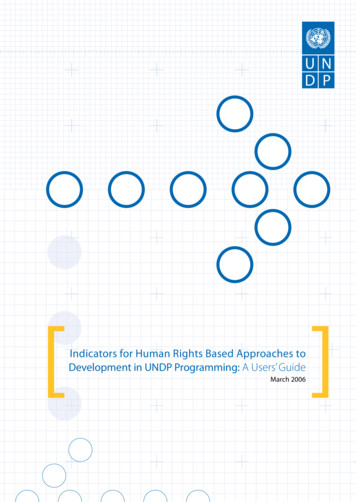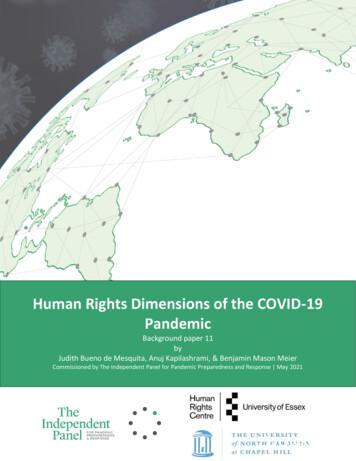RESPECTING HUMAN RIGHTS IN OUR SUPPLY CHAINS
RESPECTING HUMAN RIGHTSIN OUR SUPPLY CHAINSA practical guide to understand and address the moraland business challenges facing the energy industryOctober 2019
This white paper has been developed by EPSA INC in conjuctionwith Action Sustainability Asia Pacific.CONTENTSSpecial thanks to the following member organisations fortheir valued input to the development of this white paper:ABOUT EPSAABOUT THIS DOCUMENTEXECUTIVE SUMMARYHUMAN RIGHTS ISSUES IN PRACTICE04050607FOCUS ON THE AUSTRALIAN COMMONWEALTH MODERN SLAVERY ACT:201817100% Recycled PaperThis paper is printed on EcoStar 100% recycledcarbon neutral paper. It is manufactured from 100%post consumer recycled paper in a process chlorinefree environment under the ISO14001 environmentalmanagement system.CopyrightCopyright in this material is owned by or licensed toEnergy Procurement Supply Association Incorporated.Permission to publish, modify, commercialise or alter thismaterial must be sought directly from Energy ProcurementSupply Association Incorporated.Rules of EngagementEPSA’s mission is to deliver quantifiable benefits to itsmembers and suppliers through collaboration on supplychain processes. The members of the Group shareinformation for the purposes of progressing EPSA activitiestowards this mission but in doing so all members arereminded that;1.2.The Group shall not do, cause to do or preventany member from doing anything which would leadto a breach of the principles of fair competition asagreed under EPSA’s Model Rules - Constitution. TheGroup will not operate to take collective decisionsconcerning any supplier or contractor, and explicitlywill not discuss pricing issues relating to suppliers orcontractors.Each member is bound to protect the confidence ofall confidential information of the other members, andof EPSA collectively, as set out in the ConfidentialityAgreement to which all members are party. Eachmember will maintain a reasonable degree ofcare and diligence in protecting the confidence ofsuch information, and will not disclose confidentialinformation to non-members who are not party to thesame terms of confidentiality.RESPECTING HUMAN RIGHTS IN OUR SUPPLY CHAINS — EPSAWhat are human rights?How are human rights protected?How prevalent are human rights issues?Illustration of human rights breachesWhy and how do these issues happen?Additional resourcesWhat is the Modern Slavery Act?How should procurement contribute to the annual report?Lessons learned from the UK Modern Slavery Act:2015080910141516182022WHY SHOULD WE PROACTIVELY ADDRESS HUMAN RIGHTS?23HOW CAN WE PRACTICALLY MANAGE HUMAN RIGHTS IN OUR SUPPLY CHAINS?25IMPLEMENTATION TOOLKITWHAT'S NEXT?FOOTNOTES475153Building the business caseKey implementation principlesUnderstanding human rights risksEngaging teams and suppliersManaging human rights incidentsCollaborating with stakeholders242628323842PAGE 03
ABOUT EPSAABOUT THIS DOCUMENTThe Energy Procurement Supply Association (EPSA) is an AsiaPacific not-for-profit association that is made up of energyindustry procurement and supply professionals. EPSA activities aremanaged and delivered largely through the voluntary work of themembership.The energy industry in the Asia Pacific region, like many otherindustries across the globe, is becoming increasingly motivated totake a closer look at human rights across their supply chains.EPSA brings together members and often prospective membersto network and collaborate for the purpose of sharing andcreating tangible, sustainable business benefits to their respectiveorganisations. This includes exploring contemporary issues andbest practice opportunities that drive and enable supply chainoptimisation.EPSA holds regular conferences across the Asia Pacific region, andwhere appropriate instigates follow-up workshops on commonissues and conducts qualitative and quantitative benchmarking.Moving forward, EPSA will introduce programs that supportthe personal development of supply chain and procurementprofessionals within the energy industry.Outside of the formal conference arrangements, membersalso benefit from initiating their own simple surveys on specificcontemporary issues, sharing information to identify best industrypractices and collaborating at an Asia Pacific cluster level on aregular basis.From human rights related legislation like the Modern Slavery Act, tomaintaining social license to operate, to morally just doing the rightthing, there are many reasons why human rights is climbing higherup the procurement agenda.Taking all reasonable action to respect human rights in supplychains is a very complex issue that requires a high degree ofcollaboration.EPSA has developed this document as a first step to help the energyindustry procurement and supply chain professionals to understandand ensure that human rights are preserved through any businessdealings. The document assists in understanding the concepts ofhuman rights (including modern slavery) and develop the requiredcapability to stimulate executive level discussions and buy-in fromkey stakeholders. The document also serves as a guide on theimplementation of a human rights compliance program, includingappropriate mechanisms to detect, manage and report on humanrights issues.Tony BallardEPSA President
EXECUTIVE SUMMARYHuman rights issues are becoming an increasingly important consideration for energycompanies and their procurement teams. There is a growing demand to address theseissues through many drivers such as legislation and stakeholder expectations, howeverthere is also the moral factor to consider. That it is simply the right thing to do.Despite being the right thing to do, understanding and addressing these issues can be quite a challenge.A major challenge is getting people on board. Often it is perceived that human rights issues are notprevalent in highly regulated and developed countries such as Australia. However, the facts indicate thathuman rights issues, such as modern slavery still exist, even in developed countries and, through ourprocurement practices, we contribute to and/or perpetuate those human rights issues that exist in thecountries we buy from. The Global Slavery Index estimates that in 2018, 40.3 million people were victimsof modern slavery globally, with two thirds of victims based in the Asia Pacific region, and at least 15,000people in Australia were living in conditions of modern slavery.The UK had already recognised these issues and introduced its Modern Slavery Act in 2015. However, 4years on from their implementation, despite many ongoing awareness campaigns, there is still a need toeducate further.Ensuring people understand the breadth and severity of human rights issues that exist in our world todayand its relevance to businesses and procurement practices is vital to getting business buy in. Showing reallife evidence that human rights violations do exist, throughout the extended supply chains, makes a solidbusiness case to address the issue.Knowing where to start can be difficult. It can seem quite overwhelming at a first glance, but as anorganisation it is important to set priorities based on a balance of risks to the people, risks to theorganisation and capacity to influence. That way, you can focus your efforts in the most effective waypossible. EPSA recently conducted a risk assessment exercise to map sustainability risks and opportunitieswithin their member’s supply chains. Page 29 shows an extract of this heat map, identifying categoriesthat have high and significant human rights risks. These categories would be a good place to start forbusinesses in the energy industry.Once the priorities are set, the next challenge is to manage the complexity of dealing with extended supplychains, which can seem impossible. On page 33 of this paper, we use an example from the technologyindustry on the sourcing of conflict free minerals to help understand how we look at answering the biggestquestion: when it comes to engaging your supply chains on human rights, ’how far do you go’?By making the most of existing frameworks (i.e sustainable procurement, workplace health and safety, riskmanagement) addressing these challenges can be made simpler. In general, if you have a solid frameworkin place for sustainable procurement, managing human rights should either already form part of thatframework, or easily fit into it.Despite your efforts to prevent human rights violations, once on the journey, it is likely you will encounteran incident. This is where remediation comes into play, which essentially means driving solutions toidentify and resolve issues. Collaboration with victim’s associations is key, page 42 provides practicalinsights on what should be done to manage these wrongs.Finally, complex human rights issues cannot be solved in isolation. A call to action is therefore required fororganisations to work together. "Alone, you go faster. Together, we go further!"HUMAN RIGHTS ISSUESIN PRACTICE
HUMAN RIGHTS ISSUES IN PRACTICEWhat are human rights?Human rights recognise the inherent value of each person, regardless of background, where theylive, what they look like, what they think or what they believe. They include the right to life andliberty, freedom from slavery and torture, freedom of opinion and expression, the right to work andeducation, and many more. Everyone is entitled to these rights, without discrimination.How are human rights protected?Human rights are protected through a combination of international norms and Australian legislation:TITLETYPEDESCRIPTIONUnited NationsGlobal Compact2InternationalnormsNon-binding pact to encourage businesses worldwide to adoptsustainable and socially responsible policies, and to report on theirimplementation.United NationsGuiding Principles3Internationalnorms31 principles implementing the United Nations ‘Protect, Respect andRemedy’ framework on the issue of human rights. They encompassthree pillars outlining how states and businesses should implementthe framework, including; the state duty to protect human rights, thecorporate responsibility to respect human rights, access to remedyfor victims of business-related abuses.International Covenant onCivil and Political Rights4InternationalnormsMultilateral treaty adopted by the United Nations General Assembly.The covenant commits its parties to respect the civil and politicalrights of individuals.International LabourOrganisation (ILO)Conventions5Internationalnorms190 laws which aim to improve the labour standards of peoplearound the world. There are eight fundamental conventions (onprohibition of forced labour, child labour, the right to organise in atrade union, and suffer no discrimination) which are binding uponevery member country of the ILO.Modern SlaveryAct (2018)6LegislationAn Act which requires some entities to report on the risks of modernslavery in their operations and supply chains and actions to addressthose risks, and for related purposes. The definition of modernslavery used in the Act includes the worst forms of child labour. Theworst forms of child labour means extreme forms of child labourthat involve the serious exploitation of children, including throughenslavement or exposure to dangerous work. The worst formsof child labour does not mean all child work. See page 18 for anoverview of the Act.Criminal Code(1995)7LegislationThe rules of statute and common law which direct that certainactions are punishable by the state. Each Australian jurisdictionhas a body of criminal law, usually embedded in a CriminalCode. The Department of Home Affairs guidance specifies that"Australia’s existing criminal justice response to modern slaveryincludes specialist police investigative teams, a dedicated victimsupport program and a National Action Plan on Human Traffickingand Slavery. The Department of Home Affairs is responsible forimplementing Australia’s criminal justice response to modern slaveryand the reporting requirement."Fair Work Act(2009)8LegislationPrimary piece of legislation governing Australia’s workplaces. Itsets out rights and responsibilities of employees, employers andorganisations in relation to that employment through the NationalEmployment Standards (NES), Modern Awards and NationalMinimum Wage orders.SOURCE: UNITED NATIONS1TYPE OF RIGHTThere are many different types of human rights, some of which are highly relevant to businesses.For the purpose of this paper, a specific focus on labour rights and modern slavery (as highlighted inbold writing below, this includes forced marriage, forced labour, servitude, child labour and humantrafficking) in the examples and resources provided.DETAILSECONOMIC, SOCIAL& CULTURAL RIGHTSyy Right of selfdeterminationyy Freedom of thought,conscience andreligionINDIGENOUSRIGHTSPRIVACYRIGHTSyy Right to free, prior andinformed consentyy Native Title rightsyy Freedom fromunlawful interferencewith privacyCIVIL & POLITICALRIGHTSyy Prohibition of tortureyy Right to libertyyy Freedom ofmovementyy Freedom ofexpressionyy Forced marriageLABOURRIGHTSyy Freedom ofassociation andcollective bargainingyy Prohibition ofdiscrimination inemploymentyy Equal remunerationREGULATIONSINTERNATIONALNORMSyy Forced labouryy Servitudeyy Child labouryy Human traffickingUNITED NATIONS GLOBAL COMPACT & GUIDING PRINCIPLESInternationalCovenant onEconomic, Social &Cultural RightsUN Declarationon the Rights ofIndigenous PeoplesNative Title Act 1993Anti-discriminationlawsRacial DiscriminationAct 1975InternationalCovenant on Civil &Political RightsPrivacy Act 1988InternationalCovenant on Civil &Political RightsILO ConventionsModern Slavery Act 2018Criminal CodeFair Work Act 2009RESPECTING HUMAN RIGHTS IN OUR SUPPLY CHAINS — EPSAPAGE 09
How prevalent are human rights issues?It is a global issue:40.3MILLIONpeople in modern slavery in 201615.4MILLION71% FEMALE29% MALEin forced marriage2.78MILLIONworkplace deaths per year152MILLIONvictims of child labourSOURCE: GLOBAL SLAVERY INDEX9 & ILO10 2018PROTECTINGRESPECTING HUMAN RIGHTS IN OUR SUPPLY CHAINS — EPSA24.9MILLIONvictims of forced labourPAGE 11
As a region, Asia and the Pacific has the second highest prevalence of modern slavery:RANK66%Forced labourpercentage34%Forced marriagepercentage24.9MILLIONEstimated number of peoplein modern slavery62%Regional proportionof global estimateCOUNTRYESTIMATEDPREVALENCE*ESTIMATED ABSOLUTENO. OF VICTIMSPOPULATION1Korea, Democratic People’s Republic of (North ambodia16.8261,00015,518,0005Iran, Islamic Republic 0007Myanmar11.0575,00052,404,0008Brunei Darussalam10.95,000418,0009Papua New Guinea10.381,0007,920,00010Lao People’s Democratic 28,656,00017Indonesia4.71,220,000258,162,00018Viet ,864,0001,397,029,00022Sri Lanka2.144,00020,714,00023Korea, Republic of (South Korea)**1.999,00050,594,00024Hong Kong, 0,00026New Zealand0.63,0004,615,00027Taiwan, 5,000*Victims per 1,000 population.SOURCE: GLOBAL SLAVERY INDEX9 2018RESPECTING HUMAN RIGHTS IN OUR SUPPLY CHAINS — EPSA**Substantial gaps in data exist for the Central and East Asia subregions where, with the exception of Mongolia, surveys cannot be conducted forreasons such as (i) survey is only delivered face-to-face, (ii) survey is delivered only in the main language which many migrant workers do not speak, or(iii) national authorities would not, or were unlikely to, consent to the module on modern slavery. Unlike several countries in Western Europe where nosurveys were conducted, none of the countries in these subregions were identified as sites of exploitation by respondents in the 48 countries wheresurveys were implemented.PAGE 13
Illustration of human rights breachesEXAMPLEFORCED CHILDLABOUR IN THEGARMENT INDUSTRYHUMAN RIGHTSIN WIND TURBINESUPPLY CHAINSWhy and how do these issues happen?COUNTRYHUMANRIGHTS ISSUEPROCUREMENT OVERVIEWCATEGORYIndiaForced childlabourClothingDemocraticRepublic ofCongoForced childlabourRaw materialsAditi is a 14-year-old girl from North India,who was offered a job to spin and weavecotton in a factory in the South. She wasforced to work 16 hours a day in poorand unsafe working conditions, watch thisvideo here11 for more details.There are several key factors that increase the risk of human rights issues. The level of risk dependson a range of intersecting factors such as the conditions in the countries within which an organisationand its suppliers operate, the industries in which it operates and sources from and the supply chainprocurement practices. Where multiple high-risk factors co-exist, there is a higher likelihood ofhuman rights risk.RISK FACTORSCOUNTRYyy Poor track records on corruption and human rightsyy Prevalence of criminal organisationsMore than half of the world’s totalsupply of cobalt comes from DemocraticRepublic of the Congo (DRC), where 20%currently comes from artisanal minersin the southern part of the country.There are approximately 110,000 to150,000 artisanal miners in this region,working alongside much larger industrialoperations. Among these artisanal minersare children as young as seven whoscavenge for rocks containing cobalt inthe discarded by-products of industrialmines, and who wash and sort the orebefore it is sold. Children reportedly workbetween 10-12 hours a day in and aroundthese cobalt mines, often carrying sacks ofmineral ore weighing between 20-40 kg.yy Vulnerable workforces e.g. low skilled, temporaryjobs, poverty, high movement of migrantsyy Long and complex supply chainsyy Labour intensive industryTo find out more, read Action AidNetherlands’ report here12.AustraliaIllegal workingand wagedisputeConstructionIn 2018 more than 100 Chinese plastererswalked off the Royal Hobart Hospital jobin Tasmania over visa and pay disputes,some workers were owed up to 12,000,see ABC’s news article here13 for moredetails.POOR WORKINGCONDITIONS FORAIRPORT esManagementSydney Airport aviation workers werefound sleeping on makeshift beds amidsqualid conditions while waiting for theirnext shift. In 2017 workers were foundto be spending more than 14 hoursper day at the airport under split-shiftarrangements in order to cut costs. SeeSydney Morning Herald’s article here14 formore details.BUYER/SUPPLIERyy Lack of regulation or enforcement agenciesMinerals such as aluminium, boron,chromium, lead, manganese, iron, nickel,cobalt, copper, and zinc are used in theproduction of wind turbines.NON-PAYMENTOF WAGESINDUSTRYyy Weak labour regulations e.g. minimum wage,collective bargaining agreementsyy Prevalence of labour issues or controversiese.g. delayed payments, failure to meet labourregulations, discrimination of employeesyy High use of third-party recruitment agenciesyy Procurement practices such as cost cutting,tight deadlines, demand for cheaper goodsand servicesSOURCE: ACSI15RESPECTING HUMAN RIGHTS IN OUR SUPPLY CHAINS — EPSAPAGE 15
SPOT THE SIGNSPossible indicators that someone is a victim of human rights issues such as modern slavery:Poor living conditions—living at work, in overcrowded houses, caravans oroutbuildings, blackened out windowsIsolation—unable to communicate, unable to speak the country's language,someone else speaks on their behalfPhysical appearance—malnourished, unkempt, poor hygiene, tiredPsychological—fearful, anxious, stressed, withdrawn, confusedRestricted freedom—unable to come and go, reluctant to leave their situation,unable to produce documents, in debt, unwilling to handle moneySOURCE: UNSEEN16ADDITIONAL REFERENCESyy G
IN OUR SUPPLY CHAINS. RESPECTING HUMAN RIGHTS IN OUR SUPPLY CHAINS — EPSA PAGE 03 CONTENTS . chains, which can seem impossible. On page 33 of this paper, we use an example from the technology . this includes forced marriage, forced labour, servitude, child labour and human
Rights and gendeR in Uganda · 3 Rights & Human Rights Background Rights The law is based on the notion of rights. Community rights workers need to understand what rights are, where rights come from, and their own role in protecting and promoting rights. Community rights worker
A Human Rights Perspective by David Shiman Raising Children with Roots, Rights and Responsibilities: Celebrating the UN Convention on the Rights of the Child by Lori DuPont, Joanne Foley, and Annette Gagliardi Lesbian, Gay, Bisexual, and Transgender Rights: A Human Rights Perspective by David M. Donahue The Human Rights Education Handbook:
"The issue of terrorism is not new on the human rights agenda. Terrorism is a threat to the most fundamental human rights. Finding common approaches to countering terrorism serves the cause of human rights. Some have suggested that it is not possible to effectively eliminate ter - rorism while respecting human rights. This suggestion is
make up the International Bill of Human Rights. The provisions of the two Covenants, as well as other human rights treaties, are legally binding on . of their human rights, for example marriage and the family. 6 WOMEN’S RiGHTS ARE HUMAN RiGHTS The Convention defines d
stream human rights into development projects and to monitor and implement a human rights-based approach (HRBA) to development more generally. From the side of human rights, the demand has come from recognition among the human rights treaty monitoring bodies, the Office of the High Commissioner for Human Rights, and a variety of Special .
human rights impact of COVID-19 and COVID-19 responses on human rights; the role of global health and human rights governance actors, including the WHO, World Health Assembly, Office of the High Commissioner for Human Rights and UN human rights oversight bodies, suggesting areas of action for
mapping your supply chain is going to be very difficult." "When we engage internally [on the need to map our supply chain], I think we may be spending too much time on the 'how' question and not enough on the 'why'. - Workshop Participant Shift: Putting Principles Into Practice Respecting Human Rights Through Global Supply Chains 6
ARALING PANLIPUNAN - GRADE 5 Ikalawang Markahan Kahulugan at Layunin ng Kolonyalismo Ang Dahilan ng Espanya sa Pananakop ng Pilipinas Pananakop ng Espanya sa Pilipinas Ang Paglalayag ni Ferdinand Magellan Labanan sa Mactan Ang Ekspedisyon nina Loaisa, Cabot, Saavedra at Villalobos Ekspedisyon ng Legazpi Mga Unang Engkwentro sa Pagitan ng mga Espanyol at Pilipino Kristiyanismo sa Buhay ng mga .























